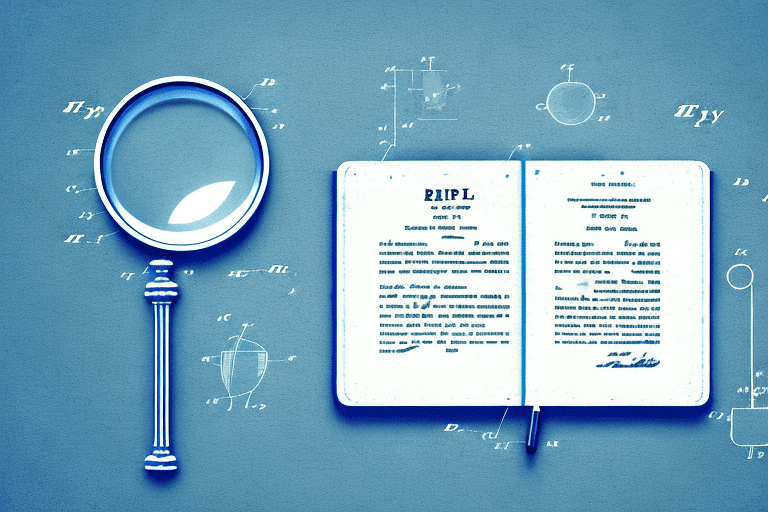Patent prosecution is a vital process in the field of intellectual property law. By understanding its definition and importance, as well as the role of a patent prosecutor, individuals can navigate this complex area effectively. Additionally, comprehending the key elements of a patent and the patent application process is crucial for successful patent prosecution. This article will provide an in-depth exploration of patent prosecution, the Manual of Patent Examining Procedure (MPEP), and the Patent Bar Examination.
Understanding Patent Prosecution
Definition and Importance of Patent Prosecution
Patent prosecution refers to the process of obtaining and defending a patent from the initial filing of the patent application to its issuance or rejection. It involves interactions between inventors or their legal representatives and the United States Patent and Trademark Office (USPTO).
During the patent prosecution process, inventors or their legal representatives work closely with the USPTO to navigate the intricate world of intellectual property law. This involves submitting detailed patent applications that describe the invention in precise terms and highlight its novelty and inventiveness. The USPTO then carefully examines these applications to determine if the invention meets the necessary criteria for patentability.
Patent prosecution is significant for inventors as it grants them exclusive rights over their inventions, allowing them to commercially exploit their ideas while preventing others from using or selling their inventions without permission. The exclusivity provided by patents gives inventors the opportunity to recoup their investment in research and development, encouraging further innovation and technological advancement.
Moreover, patents encourage innovation and economic growth by incentivizing inventors to disclose their inventions in exchange for limited monopolies. By publicly disclosing their inventions through the patent prosecution process, inventors contribute to the collective knowledge of society, enabling others to build upon their ideas and develop new technologies. This sharing of information fosters a culture of innovation and progress.
The Role of a Patent Prosecutor
A patent prosecutor, also known as a patent attorney or agent, plays a crucial role in patent prosecution. Their primary function is to represent inventors or assignees in securing and enforcing patents. Patent prosecutors utilize their legal expertise and technical understanding to navigate the complexities of patent law.
From drafting patent applications to negotiating with patent examiners, patent prosecutors ensure that the patent application meets the legal requirements set forth by the USPTO. They meticulously analyze the invention, conducting thorough research to identify prior art and assess the patentability of the invention. This involves reviewing existing patents, scientific literature, and other sources of information to determine if the invention is novel and non-obvious.
Once the patent application is submitted, patent prosecutors serve as the main point of contact between inventors and the USPTO. They communicate with patent examiners, addressing any questions or concerns raised during the examination process. Patent prosecutors skillfully advocate for the inventors, presenting arguments and evidence to support the patentability of the invention.
Throughout the patent prosecution process, patent prosecutors also play a crucial role in managing any objections, rejections, or challenges that arise. They analyze the examiner’s objections, develop strategies to overcome them, and amend the patent application if necessary. This iterative process requires a deep understanding of patent law and a keen eye for detail.
In essence, patent prosecutors act as advocates for inventors, striving to obtain the strongest possible patent protection. They are not only legal experts but also technical specialists who possess a comprehensive understanding of the invention and its underlying technology. Their expertise and dedication ensure that inventors have the best chance of securing valuable patent rights that safeguard their inventions.
The Anatomy of a Patent
Key Elements of a Patent
A patent consists of various elements that provide a comprehensive description of the invention. These elements include a title, abstract, specification, claims, drawings, and, if applicable, an oath or declaration. Each element serves a specific purpose in clarifying the invention’s scope and enabling others to understand and replicate it, if desired.
The title provides a concise and descriptive name for the invention. It is carefully crafted to capture the essence of the invention and make it easily recognizable. A well-crafted title can pique the interest of potential investors, licensees, or buyers.
The abstract summarizes the invention’s essential features. It is a concise summary that provides a high-level overview of the invention, allowing readers to quickly grasp its key aspects. The abstract serves as a window into the invention, enticing readers to explore the patent further.
The specification contains detailed written descriptions, explanations, and examples of the invention. It is the heart of the patent, providing a comprehensive understanding of how the invention works and how it can be implemented. The specification enables a person skilled in the relevant field to understand and use the invention, guiding them through the necessary steps to replicate it successfully.
The claims define the scope of protection sought by the inventor. They outline the specific rights granted by the patent, clearly stating what aspects of the invention are protected. The claims are carefully crafted to be broad enough to cover variations and embodiments of the invention, while also being specific enough to differentiate it from existing technologies.
Accompanying drawings illustrate the invention, providing visual aids that complement the written descriptions. These drawings can range from simple sketches to detailed diagrams, depending on the complexity of the invention. The drawings help readers visualize the invention, making it easier to understand and appreciate its unique features.
Finally, an oath or declaration is often required to confirm the inventor’s identity and the originality of the invention. This legal document serves as a formal statement by the inventor, affirming that they are the true creator of the invention and that it is not a copy or derivation of someone else’s work.
The Patent Application Process
The patent application process involves several stages, each requiring specific steps and documentation. Understanding this process is crucial for inventors seeking patent protection for their inventions.
The process typically starts with a thorough examination of prior art, which includes previously disclosed inventions related to the proposed invention. Conducting a comprehensive prior art search helps identify any potential obstacles or areas requiring further development. It allows inventors to assess the novelty and inventiveness of their invention in comparison to existing technologies.
Once the prior art search is complete, the inventor or their patent prosecutor prepares a patent application. This application details the invention, its unique features, and how it differs from existing technologies. It also includes the necessary elements discussed earlier, such as the title, abstract, specification, claims, drawings, and oath or declaration.
After the patent application is filed with the United States Patent and Trademark Office (USPTO), a patent examiner is assigned to evaluate the application. The examiner examines the application’s compliance with patent laws and performs a substantive review of the invention’s novelty, non-obviousness, and utility. The examiner may request amendments, argue against certain claims, or raise objections if the application does not meet the required standards.
The prosecution stage involves a back-and-forth negotiation between the inventor or patent prosecutor and the examiner. Amendments, statements, or additional evidence may be submitted to address the examiner’s concerns and overcome any objections raised. This iterative process aims to present the invention in the best light possible, eventually resulting in either the granting or rejection of the patent.
Throughout the application process, inventors may need to consult with patent attorneys or agents who specialize in patent law. These professionals provide guidance and expertise to navigate the complex patent system, ensuring that inventors have the best chance of obtaining valuable patent protection for their inventions.
Introduction to the Manual of Patent Examining Procedure (MPEP)
Overview of the MPEP
The Manual of Patent Examining Procedure (MPEP) is a comprehensive guidebook published by the USPTO. It serves as a valuable resource for inventors, patent prosecutors, and the general public to understand the USPTO’s practices, rules, and examination procedures.
The MPEP provides detailed instructions on various aspects of patent prosecution, including the requirements for patentability, documentation guidelines, examination guidelines, and general administrative procedures. It is regularly updated to reflect changes in patent laws and evolving USPTO practices.
How to Navigate the MPEP
Navigating the MPEP effectively is crucial for patent prosecutors and individuals involved in patent prosecution. The MPEP’s user-friendly layout allows for easy access to specific sections through table of contents and index references. Additionally, the search function on the official USPTO website enables users to locate relevant sections quickly.
When interpreting the MPEP, it is important to consider its hierarchical structure. Parts, chapters, sections, and subsections provide a logical organization that aids in finding specific information. Cross-references within the MPEP can also be used to navigate related topics and ensure a comprehensive understanding of patent prosecution processes.
The Patent Bar Examination
Preparing for the Patent Bar
The Patent Bar Examination is a rigorous test that aspiring patent practitioners must pass to become registered patent attorneys or agents. Preparing for the examination is essential to ensure success.
Study materials and review courses that cover patent laws, rules, and procedures are available to assist candidates in their preparation. These resources help familiarize candidates with the vast range of topics covered in the examination, including patentability requirements, patent application preparation, patent prosecution, and ethics.
Engaging in practice exams can further enhance understanding and highlight areas for improvement. Familiarity with previous exam questions and their respective solutions can provide valuable insights into the examination’s format and content.
Understanding the Format and Content of the Exam
The Patent Bar Examination follows a computer-based format and consists of multiple-choice questions. It assesses candidates’ knowledge of patent laws, regulations, and procedures, as well as their ability to apply this knowledge in various scenarios.
Questions cover topics such as patentability criteria, patent prosecution, patent litigation, patent ethics, and the MPEP. Understanding the interplay between these areas is crucial for success in the examination.
It is important to note that the Patent Bar Examination is separate from the bar exam required for general legal practice. Consequently, candidates should focus specifically on the patent-related content outlined in the examination’s guidelines and syllabus.
The Intersection of Patent Prosecution, the MPEP, and the Patent Bar
How the MPEP Guides Patent Prosecution
The MPEP serves as a guiding tool for patent prosecutors throughout the process. Its comprehensive coverage of patent laws, procedures, and examination guidelines enables patent prosecutors to ensure their patent applications meet the USPTO’s requirements.
By referring to the MPEP, patent prosecutors gain clarity on substantive rules and requirements, aiding in the preparation and review of patent applications. The MPEP assists in understanding the examiner’s perspective, allowing patent prosecutors to address objections effectively and present persuasive arguments.
The Role of the Patent Bar in Patent Prosecution
The Patent Bar Examination plays a crucial role in patent prosecution by establishing a standard of competence for patent attorneys and agents. Successful completion of the examination demonstrates a comprehensive understanding of patent laws, the MPEP, and relevant patent prosecution practices.
Registered patent attorneys or agents possess the necessary qualifications and knowledge to navigate patent prosecution effectively. Their expertise in patent laws and procedures bolsters their ability to draft strong patent applications, negotiate with patent examiners, and protect their clients’ inventions throughout the prosecution process.
In conclusion, patent prosecution encompasses the crucial steps involved in obtaining and defending a patent. Understanding the definition, importance, and role of a patent prosecutor is fundamental to achieving successful patent outcomes. Familiarity with the key elements of a patent, the patent application process, the MPEP, and the Patent Bar Examination further enhances one’s ability to navigate this intricate field. By exploring the intersection of patent prosecution, the MPEP, and the Patent Bar, individuals can effectively protect their inventions and contribute to the advancement of innovation.






